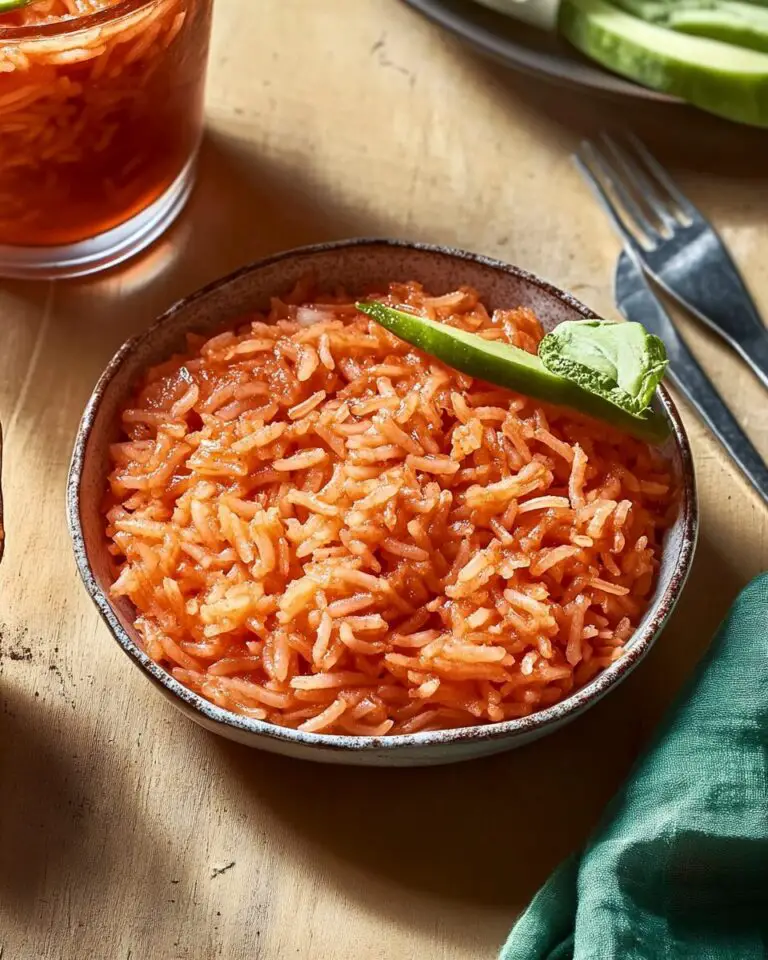Cultural Background and History
Red rice holds a special place in the heart of Mexican cuisine. It is as essential as beans, tortillas, and salsas, forming the foundation of everyday meals as well as festive occasions. Historically, arroz rojo evolved from Spanish culinary influences introduced during the colonial period. The use of rice, tomatoes, and cooking methods like toasting and simmering came together over time to become a staple in Mexican households.
Every region in Mexico offers its own variation, some richer in tomato, others enhanced with vegetables like peas or carrots. Some versions include spices like cumin or even a splash of lime juice for brightness. In all its forms, it reflects the ingenuity and adaptability of Mexican cooking, transforming simple pantry staples into something extraordinary.
The inclusion of a whole serrano chile and a sprig of cilantro is a traditional touch that adds subtle aromatics without overpowering the dish. The chile infuses a gentle heat throughout the rice, while the cilantro provides a layer of fresh herbal complexity. It’s this balance of elements—spice, freshness, and umami—that makes arroz rojo more than just rice.
Flavor Profile and Texture
The flavor of Mexican red rice is both familiar and comforting, marked by savory depth and mild acidity. The base of the dish is built on sautéed onion and garlic, which lend a warm, slightly sweet undertone to the rice. Tomato paste enriches the broth with concentrated flavor and that signature reddish hue, creating a deep umami character that’s both mellow and robust.
Toasting the rice before adding liquid is key—it develops a nutty aroma and adds a slight bite to the finished dish, preventing it from becoming mushy. The grains stay tender yet distinct, and every bite is infused with the bold essence of tomato, broth, and spice.
The whole serrano chile doesn’t make the dish overly spicy. Instead, it imparts a soft background heat that builds slowly, enhancing the experience without overwhelming the palate. This delicate layering of heat, savory broth, and fresh herbs results in a well-rounded side dish that feels like a meal in itself.
Why This Recipe Works
This version of arroz rojo is a brilliant balance of authenticity and ease. It requires minimal ingredients yet delivers maximum flavor thanks to careful layering and proper technique. The toasting of the rice at the beginning is not just traditional—it’s essential. It adds complexity to the texture and prevents the rice from clumping or becoming overly soft.
Using tomato paste instead of fresh tomatoes or tomato sauce gives the dish a rich, concentrated flavor while also controlling the water content in the rice. This allows the grains to absorb just the right amount of moisture for a fluffy finish. Chicken broth adds depth and richness that plain water can’t offer, and the use of kosher salt ensures even seasoning without harshness.
Adding a whole serrano chile and cilantro sprig rather than chopped pieces gives the dish subtlety. The chile warms the entire pot without introducing bits of spice that some diners might want to avoid. The cilantro perfumes the rice gently, adding a complex herbal note that balances the tomato base.
Health and Nutrition Benefits
Though comforting and rich in flavor, Mexican red rice is also a relatively healthy side dish when made with fresh, whole ingredients. One serving delivers moderate calories, a good amount of carbohydrates for energy, and very low fat content. The use of vegetable oil in moderation and the option to choose low-sodium chicken broth can make this dish suitable for a variety of dietary needs.
The tomato paste provides lycopene, an antioxidant known for supporting heart health and reducing inflammation. Garlic and onion contribute natural compounds that may boost immunity and support cardiovascular wellness. The serrano chile, even if used whole, contains capsaicin, which has been associated with metabolism-boosting and anti-inflammatory effects.
This dish is naturally gluten-free and vegetarian-friendly when prepared with vegetable broth. It’s an excellent base for adding cooked vegetables or legumes, such as peas or black beans, to enhance its nutritional value while maintaining its classic taste.
Serving Suggestions
Mexican red rice pairs effortlessly with nearly every classic Mexican entrée. It’s the go-to side for tacos, grilled carne asada, enchiladas, and chile rellenos. Serve it alongside refried beans or pinto beans for a complete and traditional plate. It’s also excellent with roasted chicken or pork carnitas, where its mild acidity helps cut through rich, fatty flavors.
For vegetarian or vegan meals, serve this rice with sautéed vegetables, a zesty avocado salad, or alongside plant-based tacos filled with mushrooms, jackfruit, or lentils. It makes an excellent base for rice bowls, topped with grilled veggies, corn, and a dollop of guacamole or crema.
This rice also shines when served as part of a family-style meal. Prepare a large batch for gatherings, holidays, or potlucks. It’s a crowd-pleaser and holds well in a warming dish, making it practical for feeding a group.
Tips for Perfect Results
To achieve the best texture and flavor, make sure to toast the rice thoroughly before adding the broth. It should turn a light golden color and give off a nutty aroma—this step ensures that the final dish will be fluffy and flavorful.
Use a heavy-bottomed saucepan with a tight-fitting lid to prevent the steam from escaping while the rice cooks. Resist the temptation to lift the lid or stir during the cooking process; doing so disrupts the steam and can lead to uneven cooking.
If you prefer a milder dish, use a milder chile or remove it before serving. For more pronounced heat, slice the serrano open slightly before adding it to the pot. For a brighter flavor, stir in a splash of lime juice or scatter chopped cilantro over the rice just before serving.
Leftovers can be refrigerated and reheated easily. In fact, arroz rojo often tastes even better the next day as the flavors continue to meld. You can also repurpose it into rice-stuffed peppers, burritos, or use it as a flavorful bed for grilled seafood or scrambled eggs.
Conclusion
Mexican Red Rice is far more than a side dish—it’s a beloved staple, a symbol of home cooking, and a versatile addition to countless meals. With its toasted grains, tomato richness, and subtle layers of spice and aromatics, arroz rojo brings both comfort and complexity to the table.
This particular version, inspired by Chef Marcela Valladolid, simplifies the traditional process without sacrificing authenticity. It highlights the thoughtful techniques and carefully chosen ingredients that make this dish special—from the toasting of the rice to the infusion of serrano chile and fresh cilantro.
Whether you’re preparing a weekday dinner or hosting a weekend feast, Mexican red rice is a recipe you’ll return to again and again. Its comforting flavor, vibrant color, and cultural significance make it an essential dish for anyone who loves Mexican cuisine. Once you’ve made it from scratch, you’ll never reach for boxed rice mixes again.






